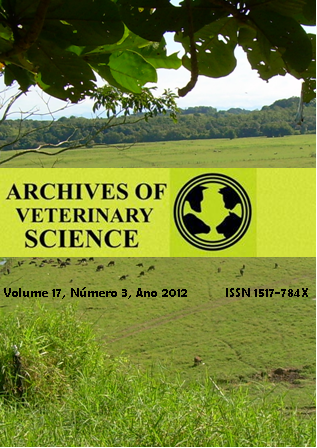REDUCTION OF THE VOLUNTARY WAITING PERIOD BY USE OF HORMONAL PROTOCOLS AND FIXED-TIME ARTIFICIAL INSEMINATION (FTAI) IN DAIRY COWS
DOI:
https://doi.org/10.5380/avs.v17i3.21676Palavras-chave:
Key words, Voluntary waiting period, reduction, dairy cows, hormonal protocols, fixed-time artificial insemination.Resumo
ABSTRACT: The aim of this study was to reduce the waiting voluntary period in dairy cows by administration of two different hormonal protocols for estrus synchronization and fixed-time artificial insemination (FTAI). One hundred twenty-eight Holstein dairy cows were studied. Three groups (G) were carried out: G1 (44 treated), G2 (34 treated) and G3 (50 as control). In the treated cows the following hormonal protocols was applied between 40 and 45 days post partum: G1- Day 0 (D0) - bovine intravaginal device containing progesterone (P4) plus 1.0 mg of estradiol benzoate (EB), D8 - removal of the P4, plus 0.5 mg of cloprostenol plus 400 IU of equine chorionic gonadotropin (eCG), D9 - 1.0 mg of EB and FTAI after 36 hours. G2 - D0 - P4 intravaginal plus 50 mcg of gonadotropin-releasing hormone (GnRH), D7 - removal of the P4 plus cloprostenol plus 400 IU eCG; D9 - 50 mcg of GnRH and FTAI 16 hours after. G3 – Control group inseminated 12 hours after the visual estrus. Results: G1 and G2 were inseminated (FTAI) respectively in the D55.5 and D56.8 after calving, while the G3 in the D84.5 (p<0.01). The pregnancy rate in the G1, G2 and G3 was respectively 47.0, 46.1 and 35.8% (p>0.05). In Conclusion: there was significant reduction in the voluntary waiting period in treated cows and higher pregnancy rate although not significant.
Downloads
Publicado
Como Citar
Edição
Seção
Licença
Autores que publicam nesta revista concordam com os seguintes termos:
- Autores mantém os direitos autorais e concedem à revista o direito de primeira publicação, com o trabalho simultaneamente licenciado sob a Creative Commons - Atribuição 4.0 Internacional que permite o compartilhamento do trabalho com reconhecimento da autoria e publicação inicial nesta revista.
- Autores têm autorização para assumir contratos adicionais separadamente, para distribuição não-exclusiva da versão do trabalho publicada nesta revista (ex.: publicar em repositório institucional ou como capítulo de livro), com reconhecimento de autoria e publicação inicial nesta revista.
- Autores têm permissão e são estimulados a publicar e distribuir seu trabalho online (ex.: em repositórios institucionais ou na sua página pessoal) a qualquer ponto antes ou durante o processo editorial, já que isso pode gerar alterações produtivas, bem como aumentar o impacto e a citação do trabalho publicado.














